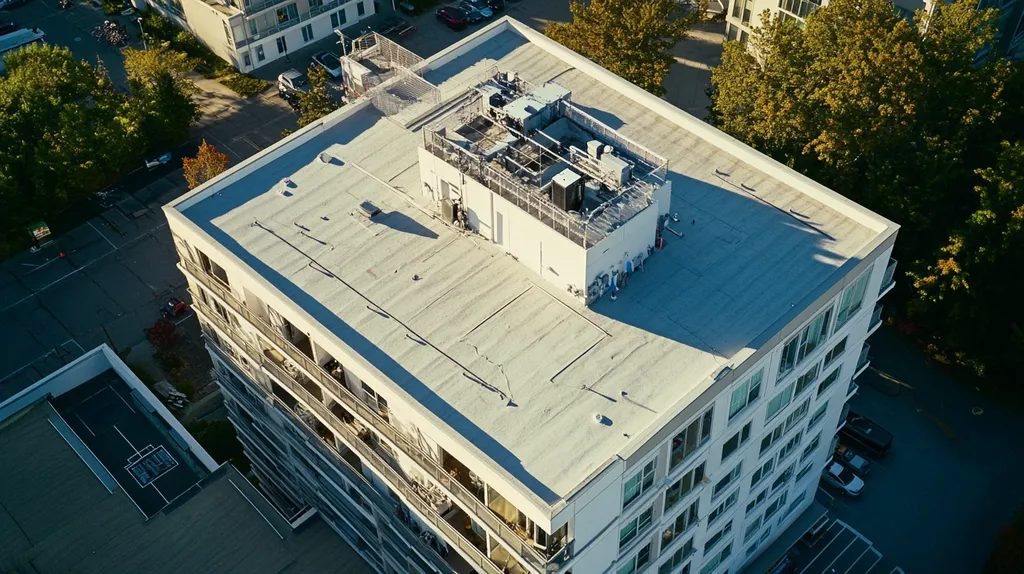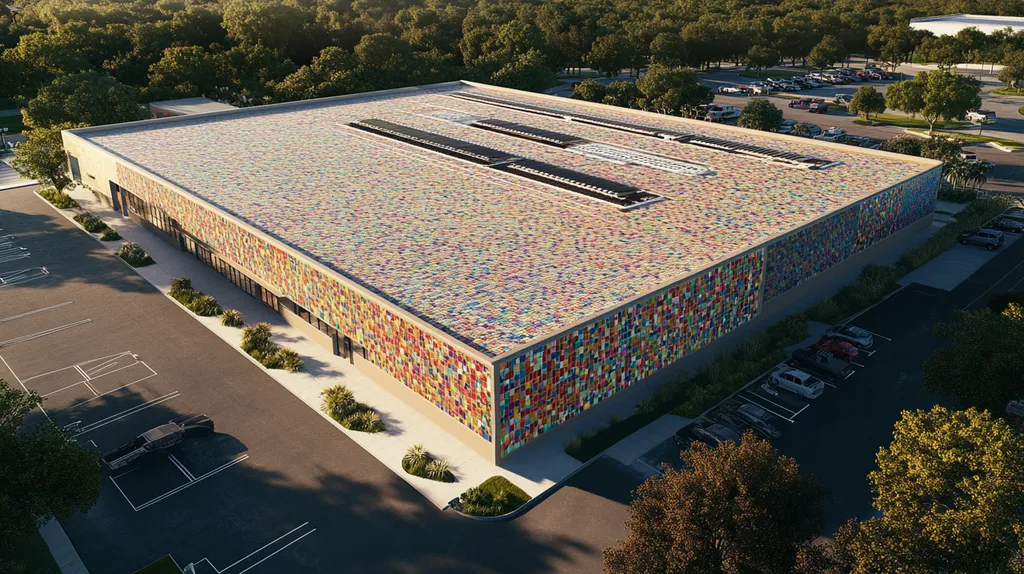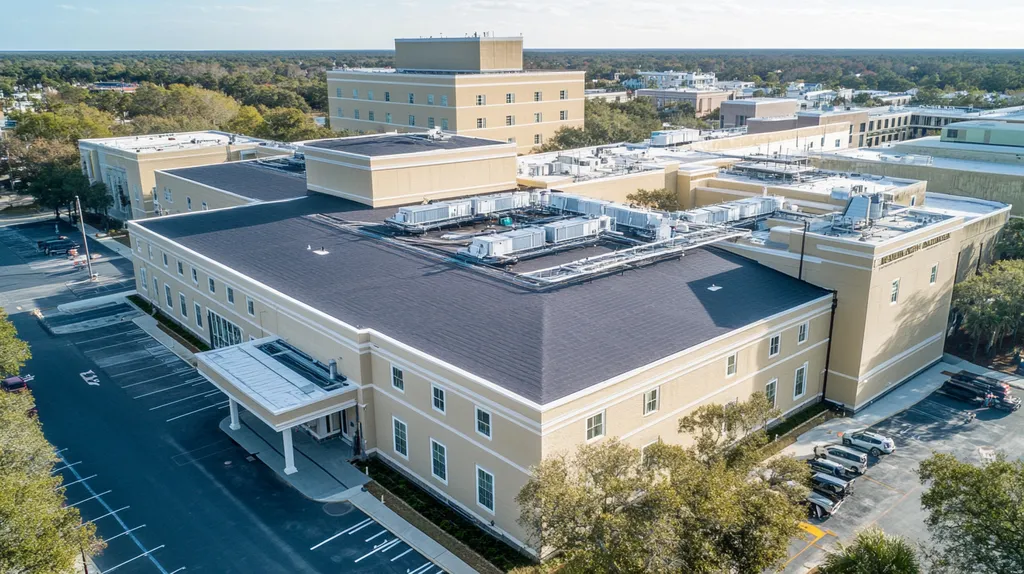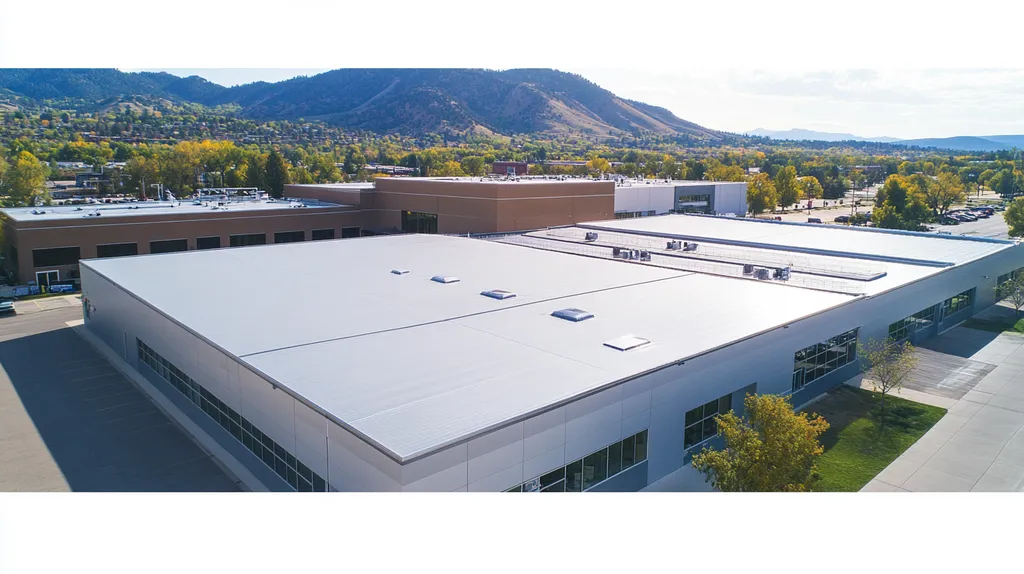Commercial roofing code violations cost property owners an average of $150,000 in fines and repairs annually, with nearly 40% of these issues stemming from unreported maintenance problems.
For facility managers, identifying and properly reporting violations represents a critical responsibility that directly impacts building safety, insurance costs, and long-term property value.
This comprehensive guide examines the essential factors in code compliance reporting, from performance assessment and financial implications to proper documentation procedures and risk management strategies.
SECTION 1: PERFORMANCE FACTORS
Facility managers must grasp the performance factors affecting commercial roofing to avoid code violations that can lead to severe consequences. Neglecting regular maintenance not only jeopardizes safety but can also double repair costs by decreasing the roof’s lifespan. This section will investigate essential components, including roof condition assessments, evaluations of structural integrity, and the often-overlooked issues surrounding water damage and leaks.
Roof Condition Assessment
To ensure compliance with roofing codes, a thorough roof condition assessment is indispensable. Regular inspections allow facility managers to spot problems before they escalate into significant violations. These assessments involve evaluating materials, age, and visible wear and tear to determine the overall health of the roof.
For example, flat roofs should be examined for surface ponding, as this may hint at deeper issues. Large commercial roofs might necessitate specialized equipment to ensure access and thorough evaluation. Proactive inspections empower facility managers to tackle minor concerns before they evolve into costly repairs.
Many property managers underestimate the critical role of these assessments. However, committing to routine inspections not only ensures code adherence but also prolongs the roof’s life. Detailed documentation from these evaluations can provide proof of compliance, safeguarding against potential liability challenges.
Key Action Items
Structural Integrity Evaluation
Assessing a roof’s structural integrity is essential for maintaining safety and compliance with local building codes. Compromised structures pose significant risks, especially in regions vulnerable to heavy snow or strong winds. Facility managers must routinely examine the underlying framework to ensure it withstands expected loads.
This evaluation generally entails inspecting rafters, beams, and the roof’s overall load capacity. Ignoring this can lead to disaster during extreme weather, resulting in serious liability concerns and costly cleanup efforts.
Moreover, specific commercial building codes dictate clear requirements for structural support systems. Non-compliance not only threatens the roof’s stability but also exposes property owners to legal challenges. Conducting thorough evaluations with qualified professionals ensures adherence to these regulations while prioritizing safety.
Key Action Items
Water Damage and Leaks
Water damage is one of the most prevalent issues leading to roofing code violations. Even small leaks can escalate quickly, causing extensive structural damage and expensive repairs. Therefore, facility managers need to remain vigilant in monitoring and addressing any signs of leaks.
For instance, water intrusion can undermine insulation and structural components, creating conditions ripe for mold growth. This poses health risks and may conflict with building codes that govern environmental safety. Proactive measures are vital for early detection to mitigate these dangers.
To effectively manage potential water issues, facility managers should implement a robust water management plan, including regular checks of drainage systems. Clogged drains often cause water accumulation, heightening the risk of leaks. By ensuring proper drainage and flow, managers can significantly reduce the risk of serious compliance violations.
Key Action Items
SECTION 2: FINANCIAL CONSIDERATIONS
Neglecting commercial roofing codes can lead to significant financial consequences for property owners and facility managers. Non-compliance often results in hefty fines, costly repairs, and increased insurance premiums. Research shows that businesses may incur an average of $15,000 in remediation costs for roofing code violations. Recognizing these financial implications is essential for sound budgeting and effective risk management in roofing projects.
Cost of Non-Compliance
For property owners, ignoring roofing codes can lead to severe financial repercussions. Local authorities impose fines for violations, which can quickly accumulate and may soar into the thousands. Non-compliant roofs are also more prone to damage, resulting in unplanned repair costs that can disrupt business operations.
In addition to immediate penalties and repair costs, long-term consequences must be considered. Non-compliance can reduce a property’s resale value, as potential buyers may demand price reductions to cover compliance issues. Furthermore, many commercial leases stipulate adherence to safety and building codes; failure to comply can result in lease disputes or even eviction, which amplifies financial risks for property owners.
Although compliant roofing solutions may seem more expensive upfront, they represent a wise investment that protects owners from greater expenses in the future.
Key Action Items
Budgeting for Repairs and Maintenance
Effective budgeting for roofing repairs and maintenance is essential to minimize long-term expenses. Property owners must allocate funds not just for immediate fixes but also for ongoing upkeep to ensure compliance with codes. Regular inspections and maintenance can identify minor issues before they become costly repairs.
A comprehensive maintenance plan should reflect the specific requirements of the installed roofing system. Experts recommend that facilities with flat roofs allocate 1-3% of the total building value annually for maintenance, a strategy that significantly reduces future repairs and bolsters code compliance.
Setting up a reserve fund for unexpected roofing expenses is a prudent step as well. Without adequate reserves, facility managers might delay necessary repairs, further complicating compliance with regulations.
Overall, a well-planned budget for repairs and maintenance demonstrates a commitment to compliance while safeguarding the property’s integrity and value.
Key Action Items
Insurance and Liability Impacts
The repercussions of roofing code violations extend beyond repair expenses to insurance and liability issues. Insurance companies may categorize non-compliance as a risk factor, resulting in higher premiums or even denial of coverage. If a major roofing issue arises and the policy does not cover code violations, the financial fallout can be substantial.
Non-compliance can also jeopardize the ability to file insurance claims in event of a roofing failure. Claims may be denied on the basis that the roof did not meet required standards, placing an extra financial burden on property owners who must bear the full repair costs.
Additionally, the liability linked to accidents caused by non-compliant roofs can severely impact an organization’s finances. If an injury occurs due to unsafe roofing conditions, the resulting lawsuits can incur significant legal fees and settlements.
Recognizing the relationship between roofing codes and insurance requirements underscores the importance of proactive compliance efforts. By prioritizing adherence to codes, businesses can effectively mitigate risks and safeguard their financial assets.
Key Action Items
SECTION 3: COMPLIANCE REQUIREMENTS
Adhering to roofing codes isn’t just a matter of following rules; it’s crucial for avoiding expensive repairs and liability. Alarmingly, nearly 40% of roofing failures stem from code violations, illustrating the need for facility managers to stay informed and proactive. This section outlines how to identify the relevant codes, navigate reporting mechanisms, and establish effective documentation practices.
Identifying Relevant Building Codes
The foundation for compliance begins with understanding which building codes apply to a facility. Because these codes can vary widely by location, facility managers must refer to local regulations. This includes checking municipal codes, state mandates, and, where applicable, federal guidelines affecting certain industries.
Focus areas should include codes tied to roofing materials, structural integrity, and safety measures. For example, in areas prone to hurricanes, the International Building Code specifies enhanced wind resistance standards. By familiarizing themselves with these requirements, facility managers can ensure roofs are built to withstand the elements.
It’s also important to stay up to date with any changes in local codes. Many jurisdictions periodically revise codes to reflect new safety innovations. Setting alerts or subscribing to newsletters from local building departments can help facility managers remain informed.
Key Action Items
Reporting Mechanisms and Agencies
After identifying any code violations, facility managers must know how to report them properly. The local building department is typically the first point of contact. Understanding which office oversees roofing codes in a specific area is essential for effective compliance management.
Many regions provide online platforms for easy reporting of violations. These systems usually allow users to upload images and descriptions of non-compliant roofing issues, expediting the documentation process. Utilizing these tools ensures prompt notification of violations, initiating necessary action.
In some instances, statewide or regional building commissions may also be relevant, especially when violations pose significant safety risks. Engaging with these larger entities can provide guidance on effective resolutions to ongoing compliance issues.
Key Action Items
Documentation and Evidence Gathering
When it comes to reporting code violations, thorough documentation is crucial. To support their claims, facility managers should compile evidence such as photographs, inspection reports, and maintenance logs. This information is invaluable in validating non-compliance issues and assists with follow-up inspections.
Establishing a routine for gathering and documenting these records can streamline the compliance process. Schedule regular reviews of roofing conditions and regulation adherence to ensure that updates are made promptly.
Collaborating with certified roofing contractors can also enhance the quality of documentation. Their expertise can lend credibility to the evidence collected, establishing a more robust case for follow-up actions. Additionally, using cloud-based storage allows facility managers to organize and easily access all relevant documentation.
Key Action Items
SECTION 4: RISK MANAGEMENT
Effective risk management in commercial roofing is essential for safeguarding safety and ensuring compliance with regulations. Failures within a roofing system can trigger severe accidents, leaks, and expensive repairs, elevating operational costs by as much as 20%. It is critical for facility managers to recognize safety risks, understand their legal obligations, and implement effective mitigation strategies. This section identifies key risk areas and offers actionable approaches for addressing them.
Safety Risks and Hazards
Safety risks in commercial roofing can significantly endanger workers and property alike. Common hazards include falling debris, improper equipment use, and exposure to hazardous materials. For instance, OSHA reports thousands of violations related to fall protection every year, highlighting the urgent need for stringent safety protocols.
Furthermore, non-compliance with safety standards can result in accidents that jeopardize worker safety and disrupt operations. Therefore, ensuring that contractors are adequately trained and adhere to safety practices is vital to minimizing these risks.
Regular inspections and audits of roofing systems can help identify potential hazards before they escalate. Fostering a safety-first culture within the organization promotes accountability and enhances overall risk management.
Key Action Items
Legal and Regulatory Risks
Legal and regulatory risks are critical concerns for facility managers overseeing commercial roofing projects. Failure to comply with local building codes can result in fines and potential legal disputes. Studies indicate that establishments with compliant roofing systems encounter 25% fewer legal issues.
It’s vital to comprehend local regulations, as they vary significantly across regions. Facility managers must stay informed about building codes, permit requirements, and safety regulations to mitigate the risk of hefty penalties.
Partnering with professionals who specialize in code compliance can ensure adherence to the latest standards. Regular discussions with legal counsel or code inspectors help clarify essential requirements and navigate complex legal landscapes. Furthermore, maintaining comprehensive documentation of all roofing-related activities is crucial for defending against potential legal challenges.
Key Action Items
Mitigation Strategies and Preventive Measures
Effective risk mitigation starts with proactive planning and preventive measures. Establishing a structured maintenance schedule for roofing systems can significantly reduce long-term costs and hazards. Regular upkeep not only extends the life of roofs but also diminishes the likelihood of unexpected failures.
Emergency response plans should be developed, outlining steps for addressing roofing issues quickly to prevent minor concerns from escalating into major liabilities. It’s also important to prioritize ongoing education about the latest roofing technologies and safety practices for team members.
Building partnerships with experienced roofing contractors can enhance accountability and quality. These professionals can offer valuable insights on compliance, material selection, and best practices tailored to specific roofing projects.
Key Action Items
SECTION 5: OPERATIONAL PROCEDURES
Compliance with roofing codes is essential not only for safety but also for maintaining legal standing. Violations in commercial and industrial roofing can lead to hefty fines and expensive repairs. Research indicates that non-compliance can cost property owners millions annually. Therefore, facility managers must establish effective operational procedures for inspections, reporting violations, and communicating with authorities to ensure that regulatory requirements are consistently met.
Inspection and Verification Protocols
Regular inspections are the cornerstone of a compliant roofing operation. Facility managers should develop a systematic inspection schedule, ideally conducting assessments at least twice a year or following severe weather events. These inspections must include thorough checks on roofing materials, drainage systems, and flashings to guarantee compliance with the relevant codes.
Utilizing qualified roofing contractors for these inspections ensures a comprehensive evaluation. Their specialized knowledge allows for the identification of minor issues before they escalate into major violations. Properly recording findings and maintaining an ongoing inspection log assists in effectively tracking compliance over time.
Incorporating digital tools into the inspection process can also enhance efficiency. Mobile applications enable facility managers to document issues on-the-go and schedule necessary repairs, streamlining workflow and ensuring timely responses to potential violations.
Key Action Items
Reporting and Follow-Up Processes
Immediate reporting is essential once a potential code violation is identified. Facility managers should have a clear process in place for promptly notifying the necessary personnel and contractors. Utilizing a structured reporting template can enhance consistency and facilitate effective communication about violations.
Follow-up actions play a critical role. After reporting a violation, establishing timelines for corrective measures helps ensure accountability. For example, if a leak is discovered, repairs should be planned and executed within a predefined timeframe to prevent further deterioration.
Regular check-ins with contractors can also guarantee that repairs conform to industry standards. It is advisable to document these communications to not only demonstrate due diligence but also provide legal protection should disputes arise.
Key Action Items
Communication with Authorities and Stakeholders
Effective communication with local authorities is crucial for maintaining compliance with roofing codes. Facility managers should stay informed about any changes in regulations or standards that could impact their properties. Building strong relationships with local building inspectors fosters a proactive approach to compliance.
Additionally, keeping stakeholders informed about roofing conditions enhances transparency and accountability. Regular updates to property owners and management teams regarding inspections, violations, and corrective actions create a culture of trust and responsibility.
Engaging with industry associations can provide further resources on compliance matters. These organizations often offer valuable training sessions and updates on the latest roofing codes, equipping facility managers with the necessary tools to maintain compliance and avoid violations.
Key Action Items
SECTION 5: OPERATIONAL PROCEDURES
Ensuring compliance with roofing codes is essential for both safety and legal accountability. Violating these codes can lead to significant penalties, with recent studies indicating that property owners may incur millions in fines each year. To navigate these risks effectively, facility managers must implement operational procedures for inspections, reporting violations, and communicating with relevant authorities. This section will provide a structured approach to uphold regulatory requirements.
Inspection and Verification Protocols
Regular inspections are fundamental to a compliant roofing operation. Facility managers should create a systematic inspection schedule, ideally conducting assessments at least twice a year or following severe weather events. Each inspection should focus on roofing materials, drainage systems, and flashings to ensure adherence to relevant codes.
Engaging qualified roofing contractors for inspections guarantees a thorough evaluation. Their expertise enables the identification of minor issues before they develop into serious violations. Keeping a well-maintained inspection log is crucial for tracking compliance over time.
Additionally, embracing digital tools can streamline the inspection process. Mobile applications allow facility managers to efficiently document issues and schedule repairs, fostering a quicker response to potential violations. This proactive stance enhances the integrity of the roofing system and mitigates risks effectively.
Key Action Items
Reporting and Follow-Up Processes
Immediate reporting is critical when a potential code violation is spotted. Facility managers should outline a clear process for promptly notifying the appropriate personnel and contractors. Adopting a standardized reporting template can help ensure clear and consistent communication regarding violations.
Follow-up actions are equally vital. After documenting a violation, establishing timelines for necessary corrective measures promotes accountability. For example, if an inspection reveals a leak, then scheduling repairs within a set timeframe is essential to prevent further damage.
Conducting regular follow-ups with contractors helps ensure that repairs meet industry standards. It is beneficial to document these exchanges centrally, providing legal protection and showcasing due diligence in addressing violations.
Key Action Items
Communication with Authorities and Stakeholders
Effective communication with local authorities is key for maintaining compliance. Facility managers should stay informed about any changes in roofing codes and standards that may impact their properties. Developing strong relationships with local building inspectors promotes a proactive compliance strategy.
Furthermore, keeping stakeholders informed about roofing conditions fosters transparency. Regular updates to property owners and management teams regarding inspections, violations, and corrective actions can cultivate a culture of accountability, which enhances trust between facility managers and stakeholders.
Additionally, engaging with industry associations can provide valuable resources and insights on compliance. Such organizations often offer training sessions and updates on roofing codes, equipping facility managers with the necessary tools to maintain compliance and avert violations.
Key Action Items
The Bottom Line
Commercial roofing code violations cost U.S. businesses over $2.5 billion annually in fines, repairs, and lost productivity.
Facility managers who implement systematic inspection protocols and maintain detailed documentation reduce their violation risks by up to 75%.
The stakes are particularly high given that 40% of structural failures stem from unreported or unaddressed code violations, putting both property and lives at risk.
By following established reporting procedures, maintaining clear communication channels with authorities, and prioritizing preventive maintenance, organizations can significantly minimize their exposure to costly penalties and safety hazards.
The investment in code compliance today prevents major financial and legal consequences tomorrow while ensuring the long-term integrity of commercial roofing systems.
FREQUENTLY ASKED QUESTIONS
Q. What performance factors impact commercial roof compliance?
A. Understanding performance factors such as roof condition, structural integrity, and water damage is crucial. Regular inspections help identify issues early, avoiding violations and costly repairs. Neglecting assessments can lead to severe liabilities, making proactive management essential for facility managers.
Q. How does non-compliance of commercial roofing affect finances?
A. Ignoring roofing codes can lead to hefty fines, increased repair costs, and higher insurance premiums. Without compliance, property values may decrease, resulting in significant financial losses for owners and facility managers. Investing in compliant solutions ultimately protects against these dangers.
Q. How do I identify building codes for my industrial roof?
A. Facility managers should review local, state, and federal regulations impacting roofing. Knowing specific codes related to materials and structural safety ensures compliance. Staying updated with code changes through local building departments is also essential for maintaining regulatory standards.
Q. What safety risks should I monitor for my commercial roof?
A. Common safety hazards include falling debris, improper equipment usage, and exposure to risks. Ensuring safety protocols and conducting regular inspections can help identify and mitigate these risks, preserving worker safety and compliance with laws governing roofing practices.
Q. How can I improve compliance communication with stakeholders?
A. Regular updates on roofing inspections and violations foster transparency. Communicating timely information encourages accountability among stakeholders, helping to build trust. Organizing quarterly meetings can further enhance awareness of compliance efforts within the organization.
Q. What are essential procedures for roofing inspections?
A. Establish a systematic inspection schedule, ideally bi-annually or post-storms. Engage qualified contractors for thorough evaluations, document findings, and utilize mobile apps for efficient reporting. This structured approach safeguards compliance while enabling timely repairs and ongoing maintenance.
Q. What should my emergency response plan include for roofing issues?
A. An effective emergency response plan should outline specific steps for quickly addressing roofing issues. This method prevents small problems from escalating into major liabilities. Including roles and responsibilities along with contact information for contractors enhances the effectiveness of your response strategy.











